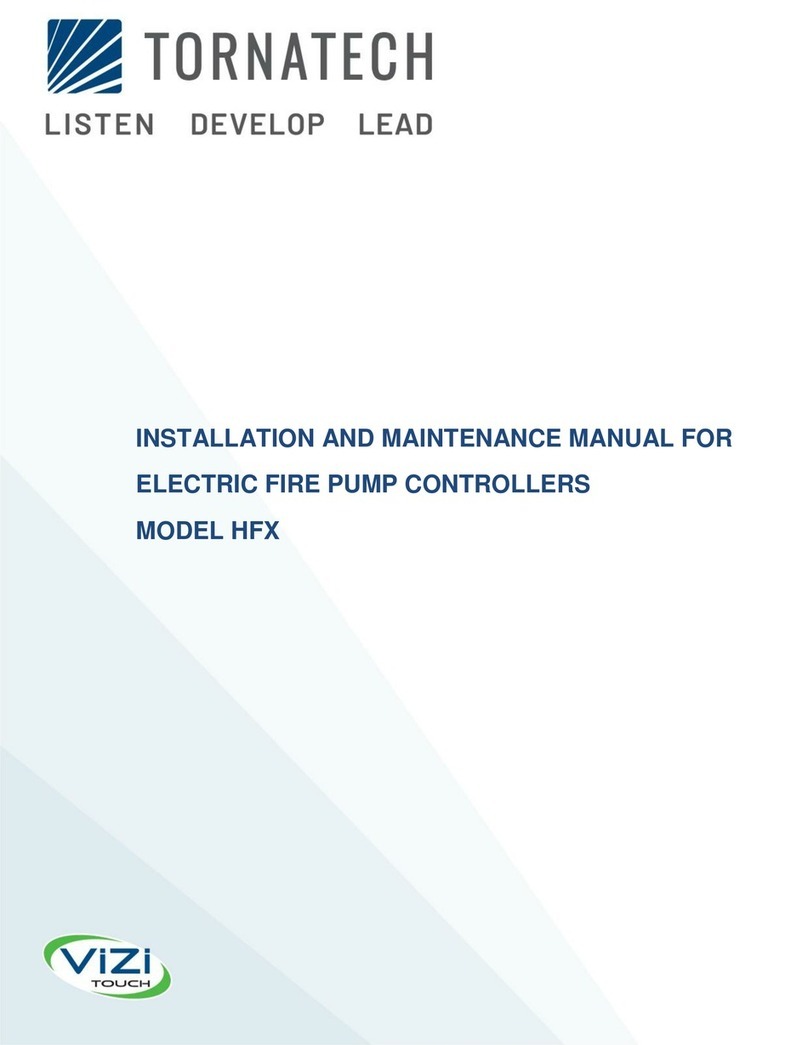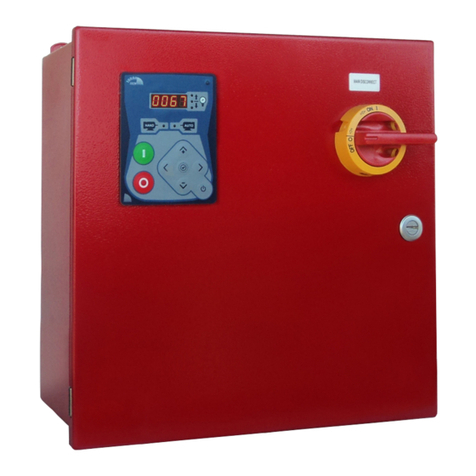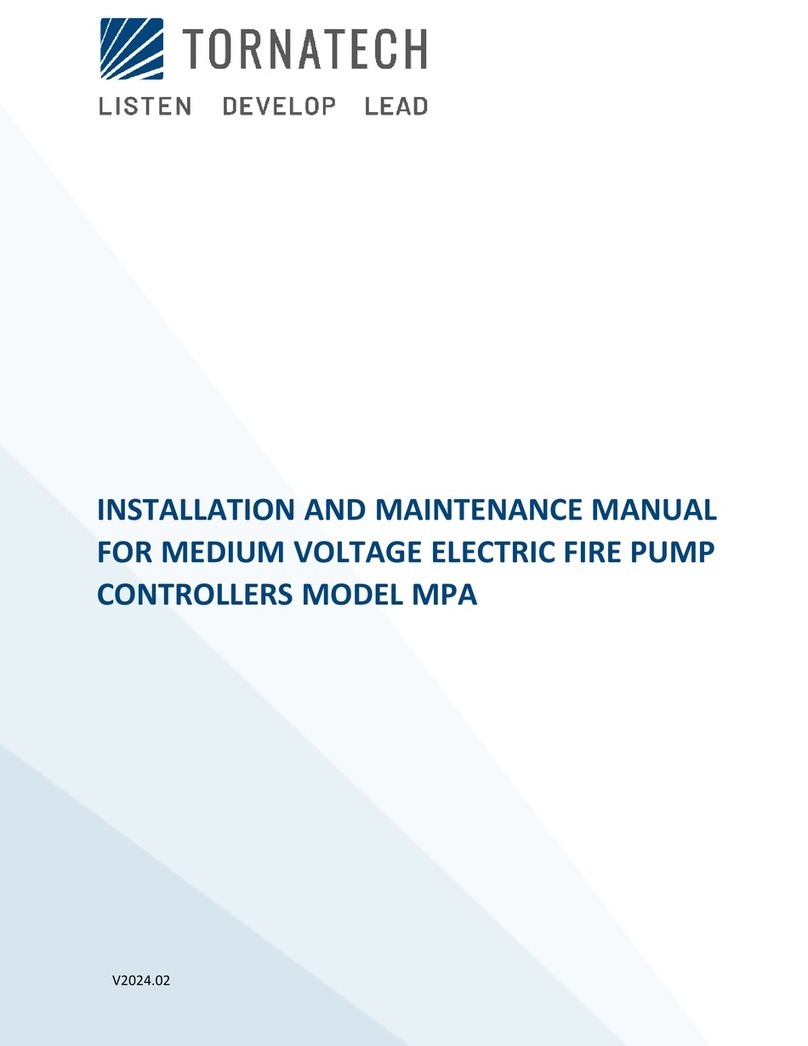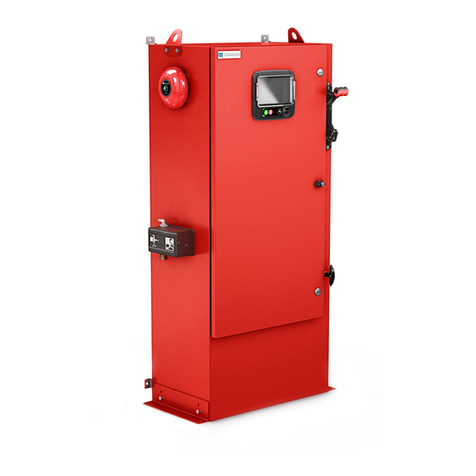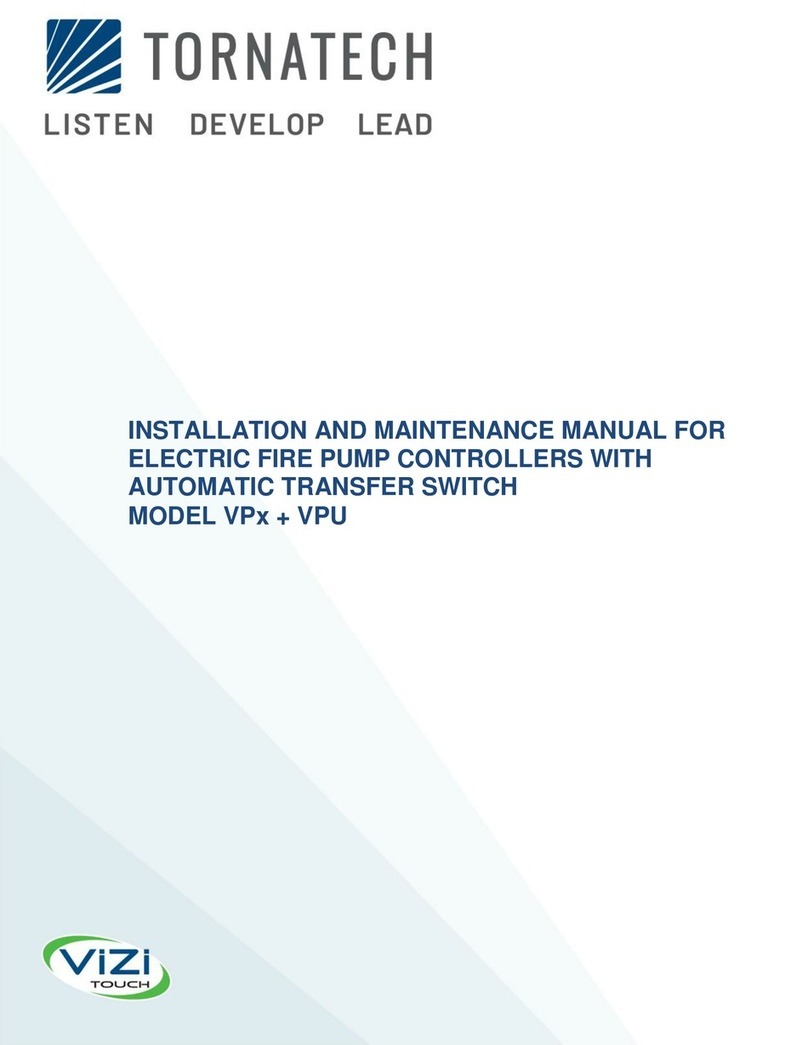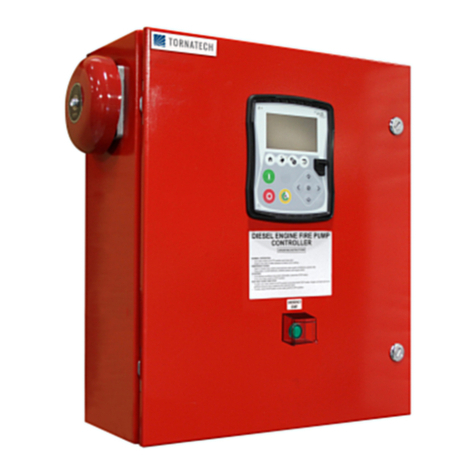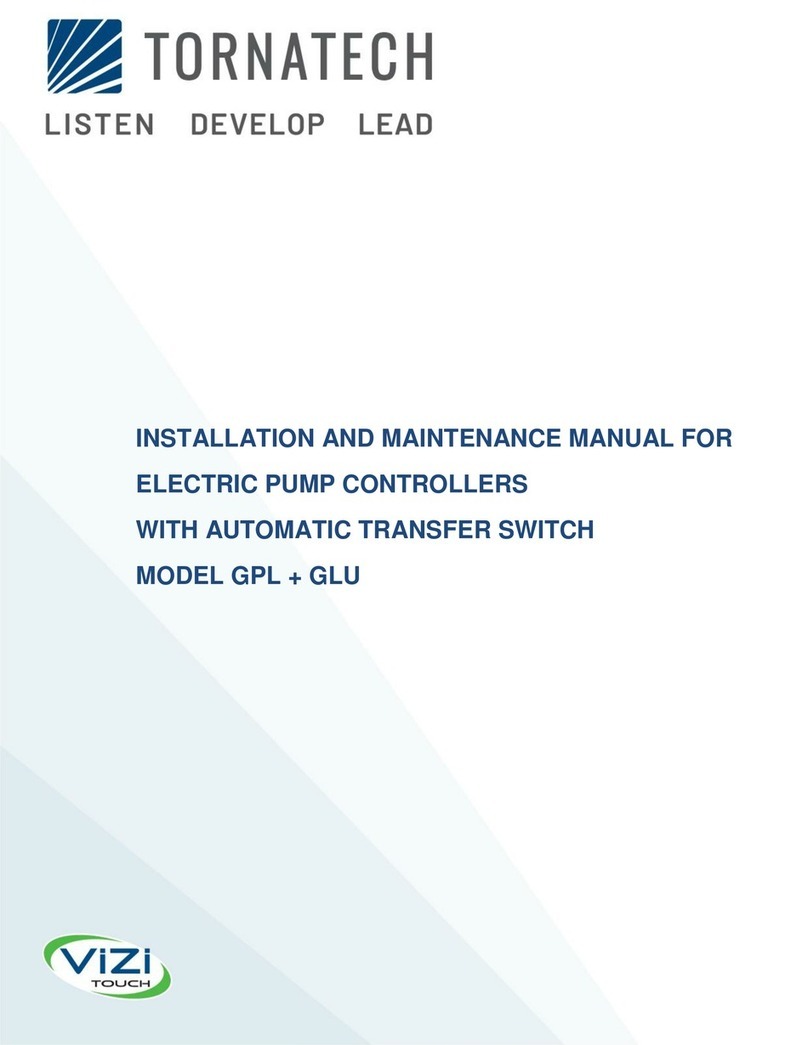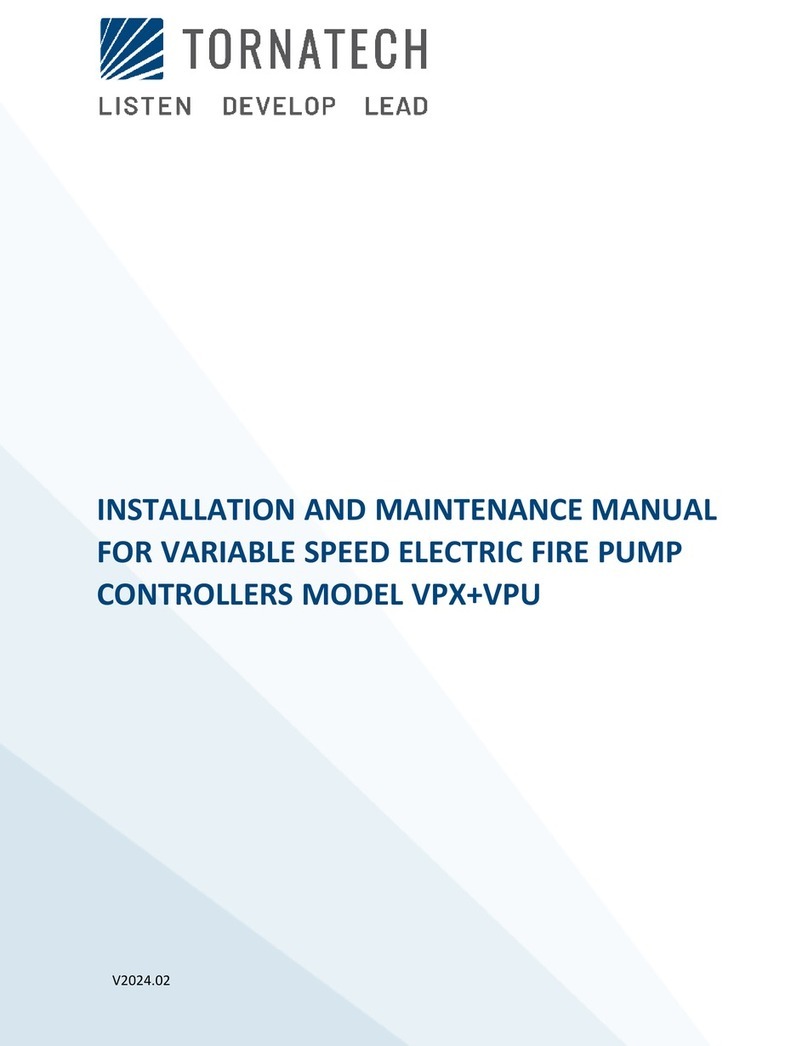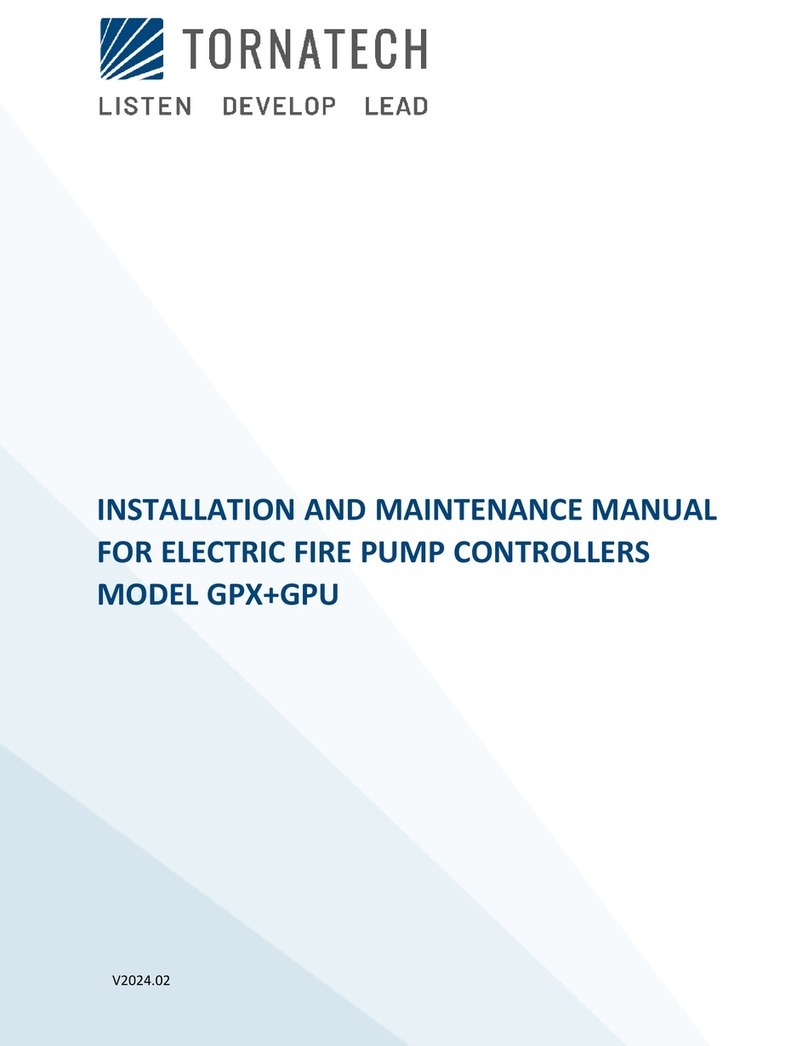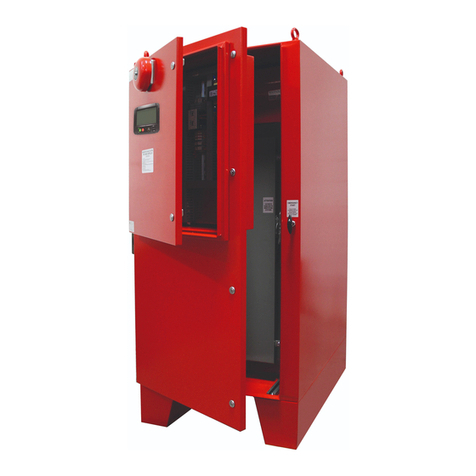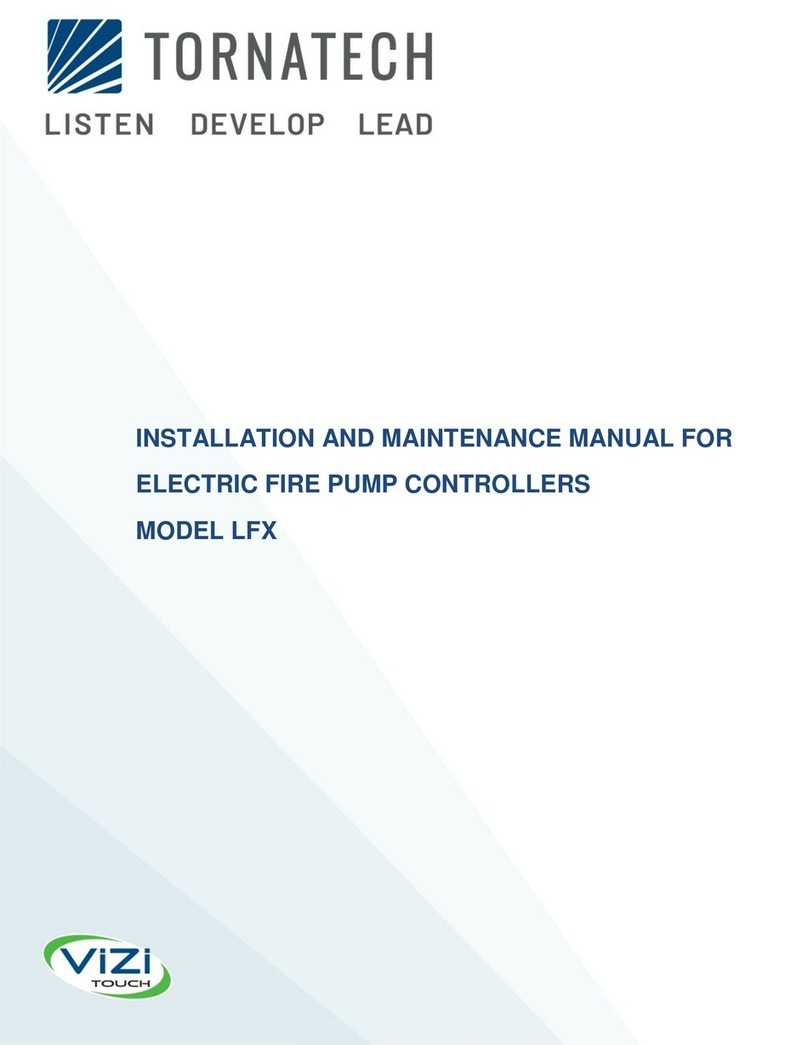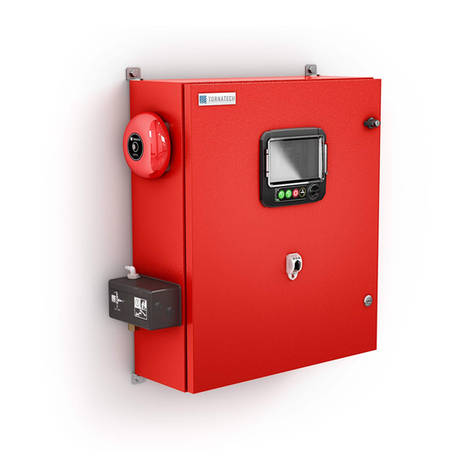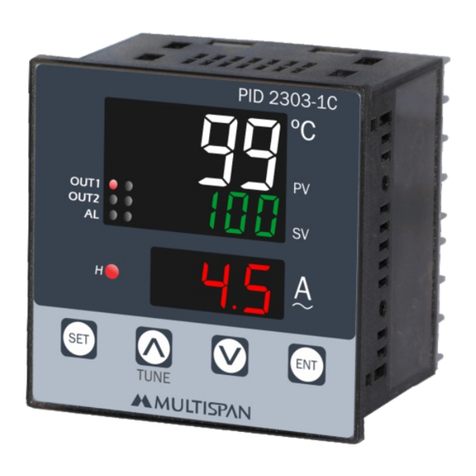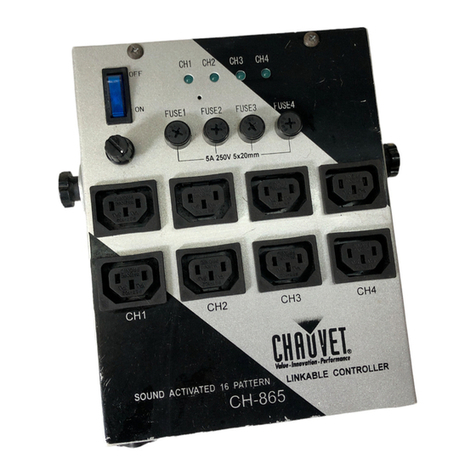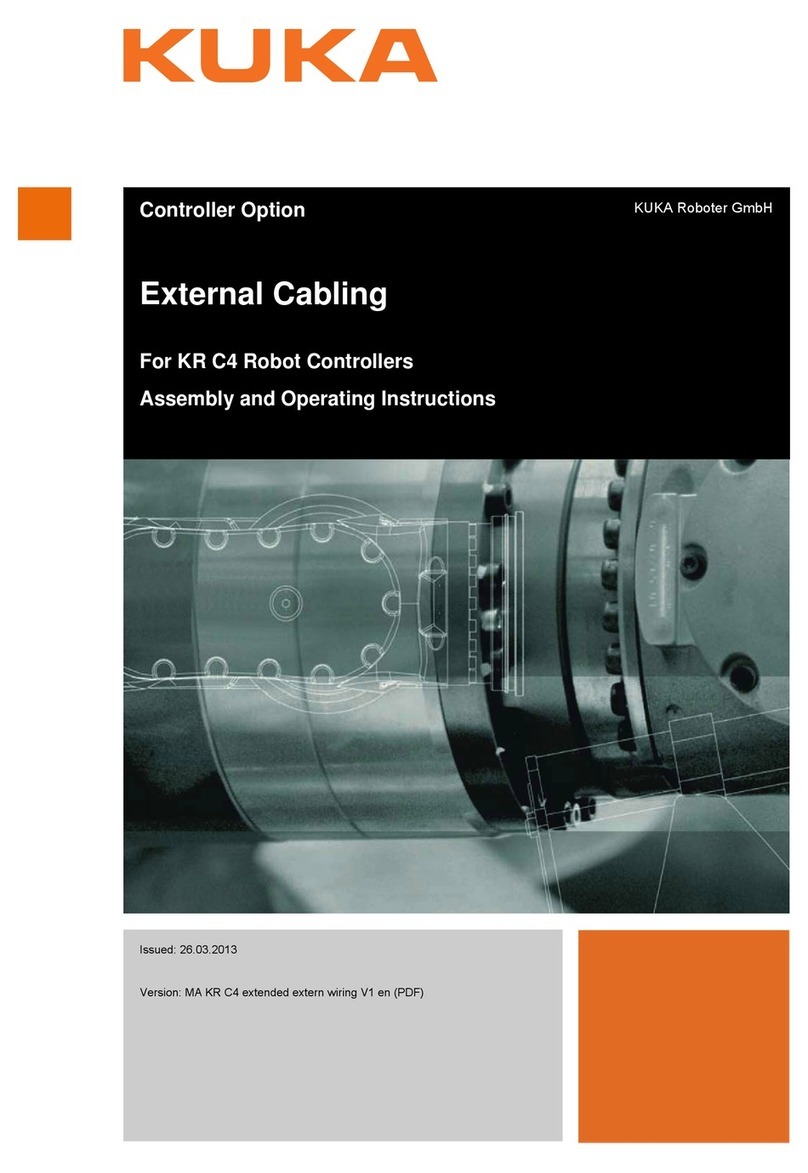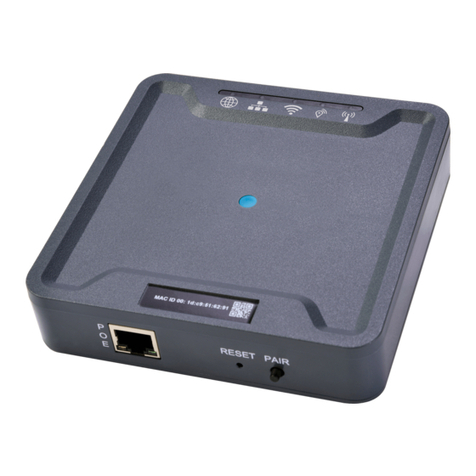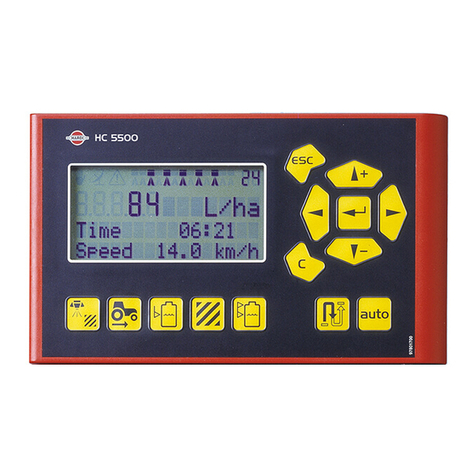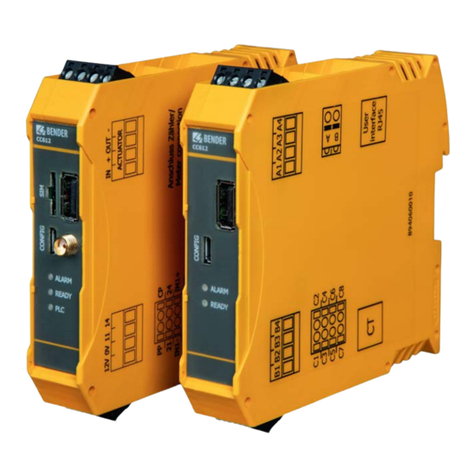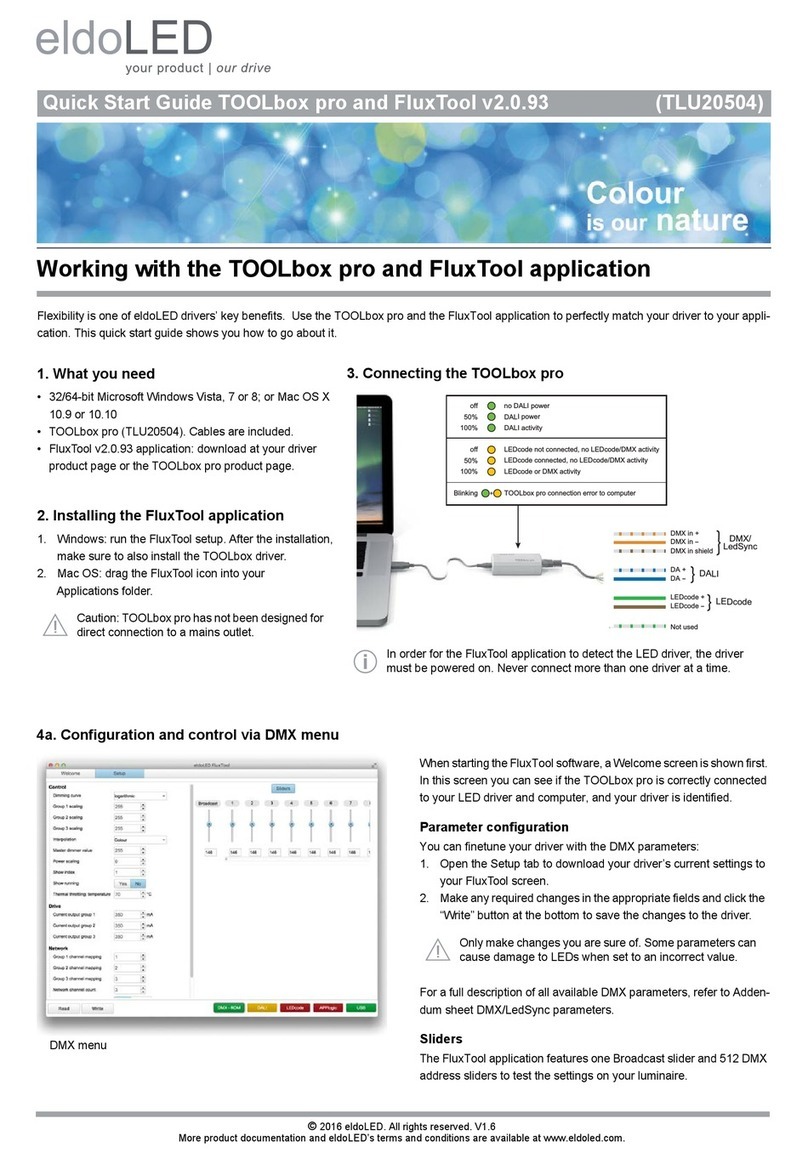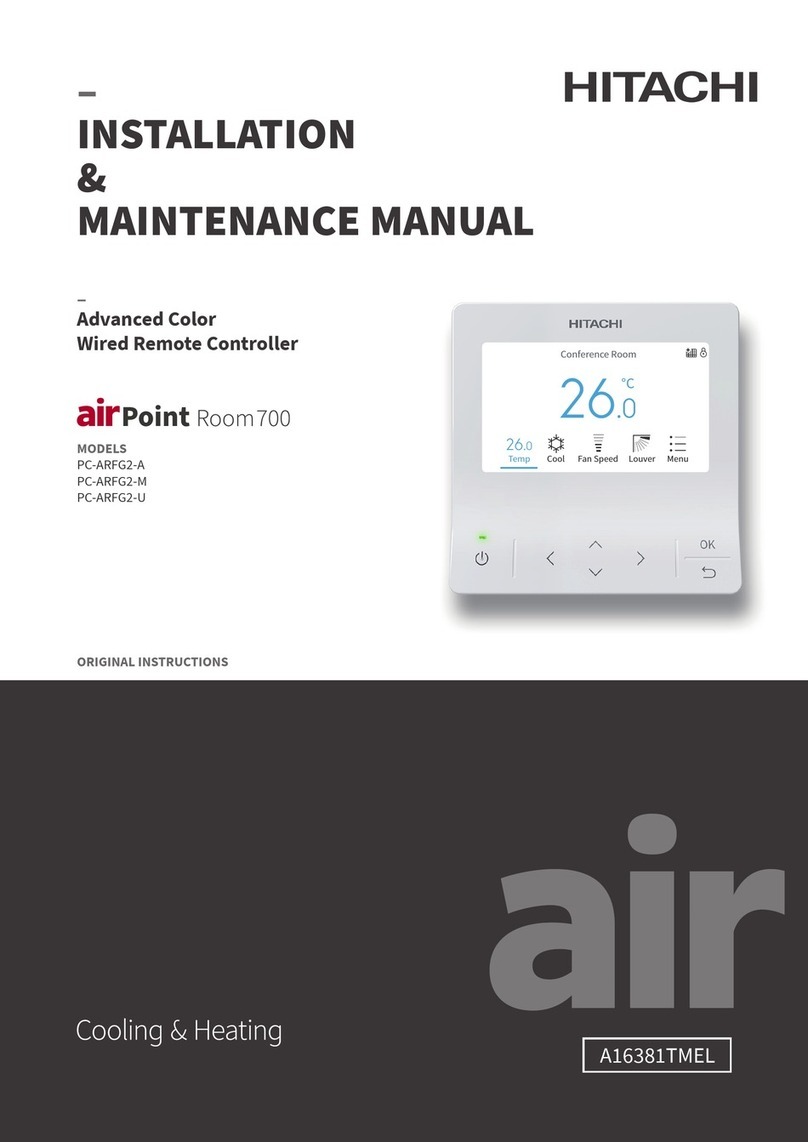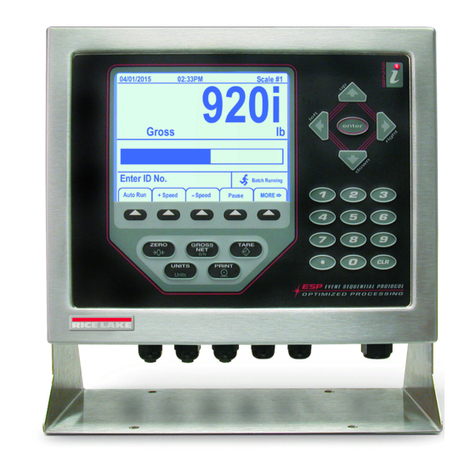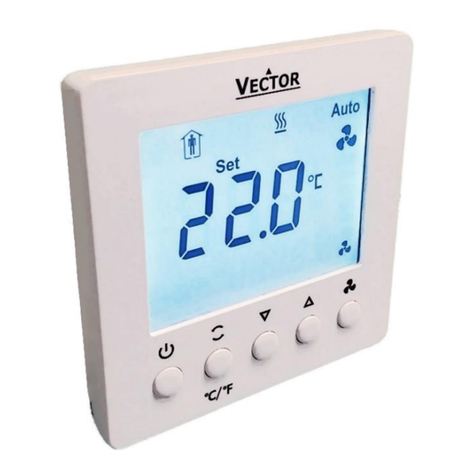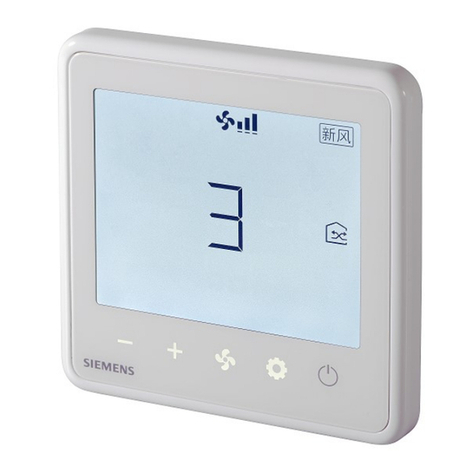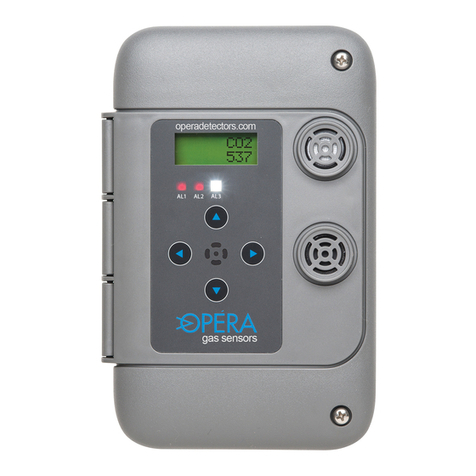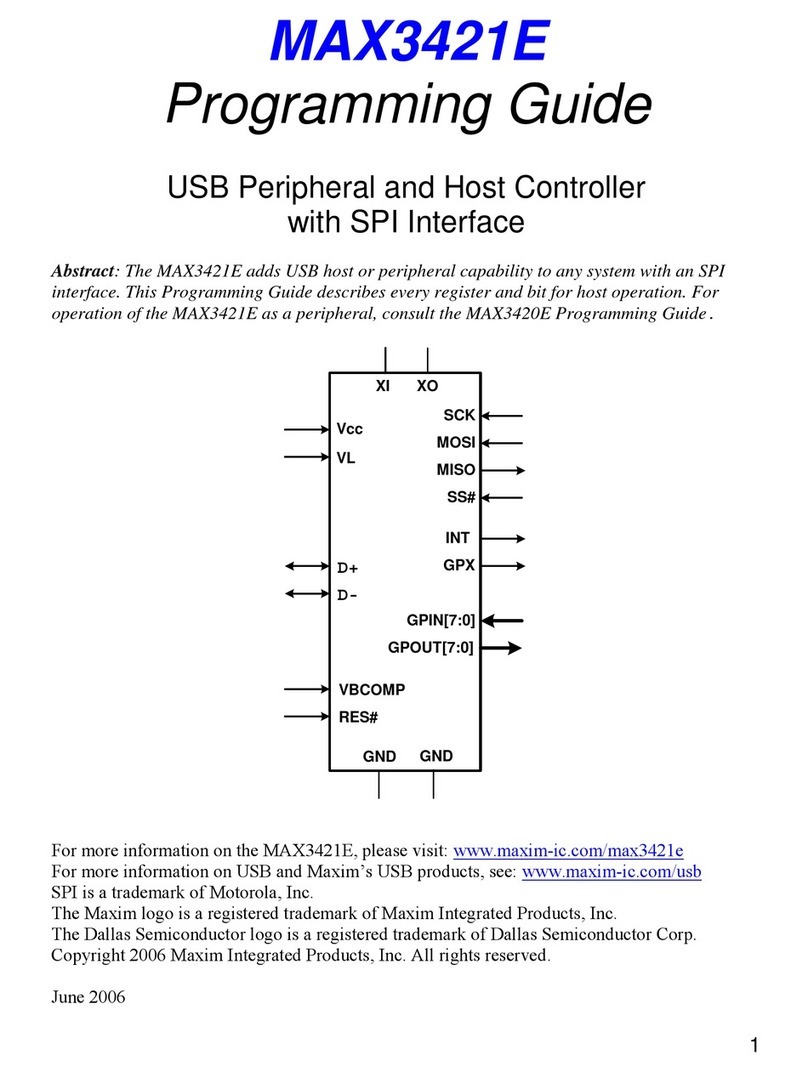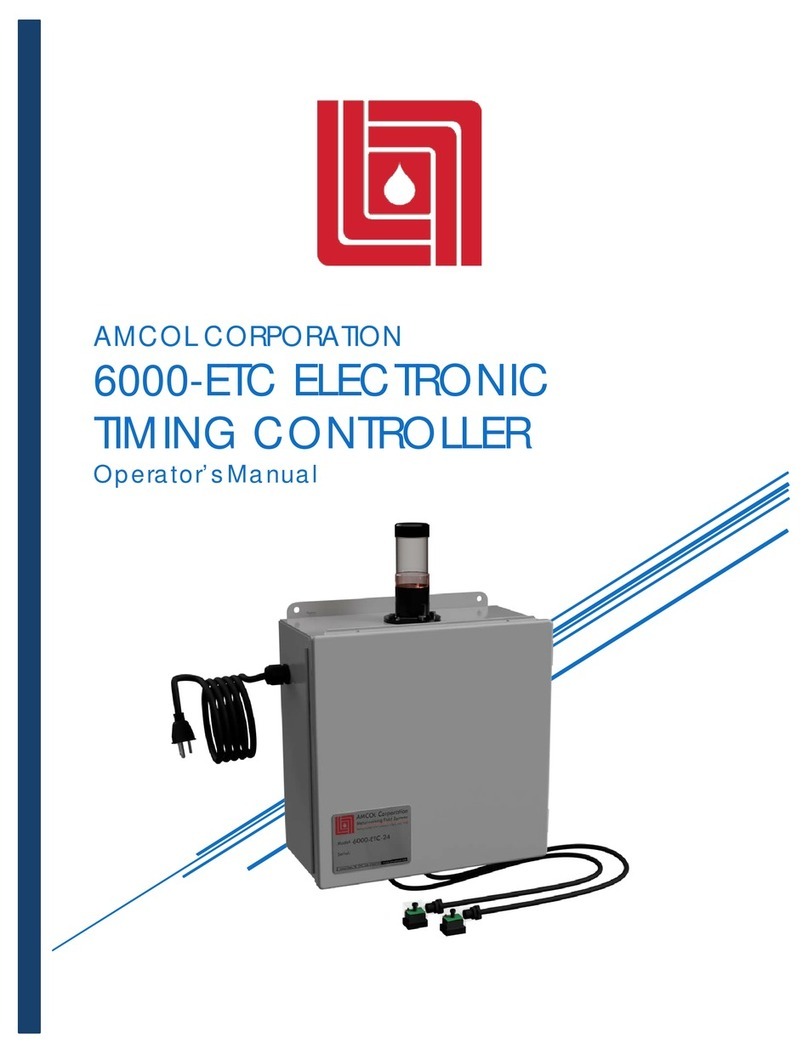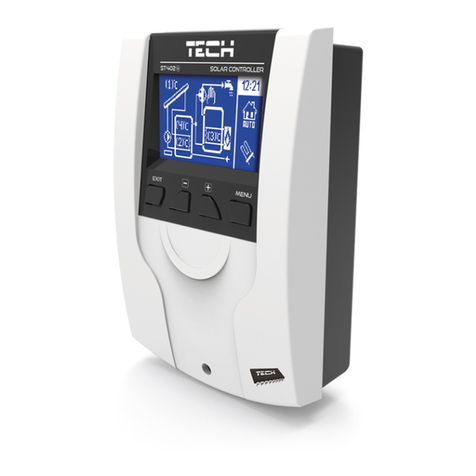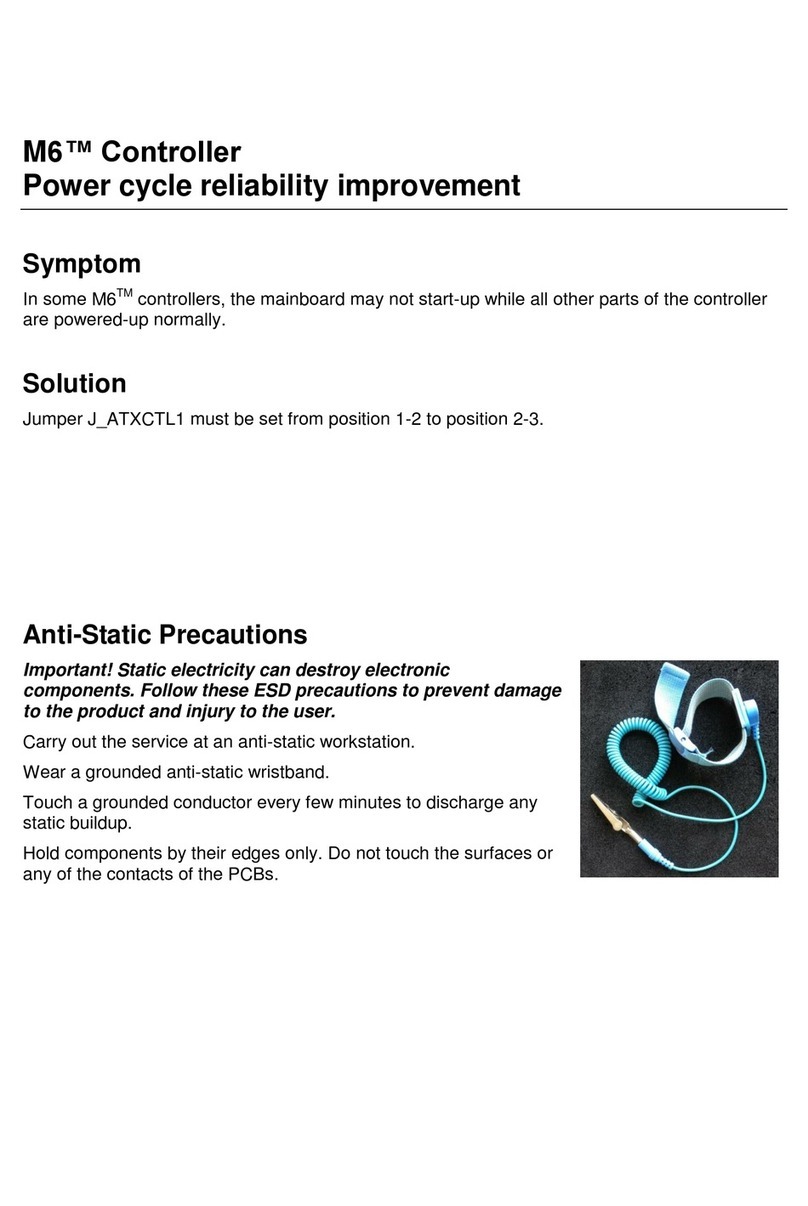Tornatech GFX Manual

1
INSTALLATION AND MAINTENANCE MANUAL FOR
ELECTRIC FIRE PUMP CONTROLLERS
MODEL GFX

2
GFX-Manual-EN v1.3.0.0
Table of Contents
1. Introduction
2. Installation
3. Main Features
4. Home
5. Alarms
6. Configuration
7. History
8. Technical Documents

3
Table of Contents
Introduction......................................................................................................................................................................5
Types of Electric Fire Pump Controllers ....................................................................................................................5
Methods of Starting/Stopping.....................................................................................................................................6
Installation.......................................................................................................................................................................8
Location......................................................................................................................................................................8
Mounting ....................................................................................................................................................................8
Storage.......................................................................................................................................................................8
Wiring and Connections.............................................................................................................................................8
Water Connections.....................................................................................................................................................8
Electrical Wiring .........................................................................................................................................................9
Electrical Connections................................................................................................................................................9
Energy Consumption..................................................................................................................................................9
Sizing..........................................................................................................................................................................9
Incoming Power Connections ....................................................................................................................................9
Motor Connections.....................................................................................................................................................9
Terminal Strip Descriptions......................................................................................................................................10
Quick Start-Up Guide...............................................................................................................................................11
Main Features ...............................................................................................................................................................16
The ViZiTouch..........................................................................................................................................................16
First Setup................................................................................................................................................................17
Home.............................................................................................................................................................................18
Home (Membrane button)........................................................................................................................................18
Screen Saver ...........................................................................................................................................................20
Alarms...........................................................................................................................................................................21
Alarms (Membrane button) ......................................................................................................................................21
Configuration.................................................................................................................................................................24
Config (Membrane button).......................................................................................................................................24
NumPad Page..........................................................................................................................................................25
Date and Time Page................................................................................................................................................25
User Login Page / KeyPad Page .............................................................................................................................26
Advanced Configuration Page .................................................................................................................................27
Details of the Advanced Configuration Page...........................................................................................................27
Timers Page.............................................................................................................................................................27
Voltage Calibration...................................................................................................................................................28
Current Calibration...................................................................................................................................................28
Inputs/Outputs Expansion board 1-2-3-4.................................................................................................................29
Update Program Page .............................................................................................................................................30
Factory Settings .......................................................................................................................................................30
Reset to Factory Settings Page ...............................................................................................................................31
The Sensors Pages..................................................................................................................................................32

4
Interlock Lockout......................................................................................................................................................34
History...........................................................................................................................................................................36
History (Membrane button) ......................................................................................................................................36
Details of the History Page ......................................................................................................................................37
Events Page.............................................................................................................................................................37
Download to USB Device.........................................................................................................................................37
The Statistics............................................................................................................................................................39
All Time Statistics.....................................................................................................................................................39
Pressure Curves ......................................................................................................................................................39
Graphical Mode........................................................................................................................................................39
Textual Mode ...........................................................................................................................................................40
Technical Documents....................................................................................................................................................41
Pre-Field Acceptance Test.......................................................................................................................................42
Field Acceptance Test Report..................................................................................................................................44

5
Electric fire pump controllers are designed to start an electric motor driven fire pump. It can either start the fire
pump manually through the local start pushbutton or automatically through the sensing of a pressure drop in the
sprinkler system. The fire pump controller is supplied with a pressure transducer. The fire pump can be stopped
manually with the local stop pushbutton or automatically after the expiration of a field programmable timer. In both
cases, stopping is only allowed if all starting causes have disappeared.
Types of Electric Fire Pump Controllers
FIRE PUMP CATALOG NUMBER
MODEL No. EXAMPLE: GFA - 208 / 160KW / 3 / 60
Model Prefix: GFA
Voltage: 208 V
HP/KW Rating: 215Hp / 160KW
Phase: 3
Frequency: 60 Hz
ACROSS-THE-LINE STARTER
MODEL GFA:
This model is intended to be used where the local utility or the capacity of the power source permits across-
the-line starting.
Full voltage is applied to the motor as soon as the controller receives a start command.
REDUCED VOLTAGE STARTERS
These models are intended to be used where the local utility or the capacity of the power source does not permit full
voltage starting.
In all the reduced voltage models, the manual “EMERGENCY RUN” device will initiate across-the-line starting.
MODEL GFR: AUTOTRANSFORMER STARTER
This model does not require a multi-connection motor. It only requires 3 conductors between the controller
and the motor.
Upon a start command, an autotransformer is utilized to supply reduced voltage to the motor. After a time
delay, the autotransformer is shunted out and the motor is connected to full voltage by a closed transition
switching sequence.
MODEL GFS: SOLID STATE STARTER
This model does not require a multi-connection motor. It only requires 3 conductors between the controller
and the motor.
Upon a start command, a solid-state starter is utilized to supply a step less ramp-up voltage to the motor
until the motor reaches its full speed. At that time, a fully horsepower rated by-pass contactor is energized
connecting the motor directly to full voltage and eliminating all heat loss within the solid-state starter.
This controller also features a soft motor stopping mode and a hard stop mode. For a hard stop, hold the
stop pushbutton until the motor stop.
MODEL GFW: WYE-DELTA CLOSED TRANSITION STARTER
This model requires a multi-connection motor and 6 conductors between the controller and the motor.
Upon a start command, the motor is connected to the line in the wye connection. After a time delay, the
motor is reconnected to the line in the Delta configuration applying full voltage to the motor windings by a
closed transition switching sequence.
Introduction

6
The power source does not « see » any open circuit during the transition from wye to delta. During the
transition from Wye to Delta, a resistor bank is connected in the starting circuit and allows to keep the motor
coils energized. An 80 second delay is then triggered and prevent the motor from stoping. This delay allows
the resistors to cool down and will only be triggered if the transition occur. An emergency stop can still be
perform by pulling the disconnecting mean handle.
MODEL GFY: WYE-DELTA OPEN TRANSITION STARTER
This type of starter requires a multi-connection motor and 6 conductors between the controller and the
motor.
Upon a start command, the motor is connected to the line in the Wye connection. After a time delay, the
motor is reconnected to the line in the Delta configuration applying full voltage to the motor windings. This
controller is of the open transition type. The motor is disconnected from the line during the transition from
start (wye) to run (delta) mode.
Methods of Starting/Stopping
The controllers are available as combination automatic / non-automatic with provision for manual or automatic
shutdown (an automatic shutdown is only possible after an automatic start).
METHODS OF STARTING
AUTOMATIC START
The controller will start automatically on low pressure detection by the pressure sensor when the pressure drops
below the cut-in threshold.
MANUAL START
The motor can be started by pressing the START push button, regardless of the system pressure.
REMOTE MANUAL START
The motor can be started from a remote location by momentarily closing a contact of a manual push button.
REMOTE AUTOMATIC START, DELUGE VALVE START
The motor can be started from a remote location by momentarily opening a contact connected to an automatic
device.
EMERGENCY START
The motor can be started manually by using the emergency handle. This handle can be maintained in a closed
position.
Important: to avoid damaging the contactor, it is recommended to start the motor in this manner:
1) Shutdown the main power by using the main disconnect means,
2) Pull the emergency handle and lock it in closed position,
3) Turn the power back on by using the main disconnect means.
SEQUENTIAL START
In case of a multiple pump application, it may be necessary to delay the automatic (pressure drop) starting of each
motor to prevent simultaneous starting of all motors.
TEST START
The motor can be started manually by pressing the run test button.
METHODS OF STOPPING
MANUAL STOP
Manual stop is done by pressing the priority STOP push button. Note that pressing the stop push button will
prevent the motor from restarting as long as the button is pressed, plus a two second delay.

7
AUTOMATIC STOP
Automatic stop is possible only after an automatic start and this function has been activated. When this function is
enabled, the motor is automatically stopped 10 minutes after the restoration of the pressure (above the cut-out
threshold) given that no other run cause is present.
EMERGENCY STOP
The emergency stop is always possible in any starting condition and is done by using the main disconnecting
means located on the door.

8
The GFx electric fire pump controller is intended to be installed in accordance with the Standard of the National Fire
Protection Association for the Installation of Centrifugal Fire Pumps, NFPA n°20-2013 (Centrifugal Fire Pumps) and
in USA National Electrical Code NFPA 70
in Canada Canadian Electrical Code, Part 1
others * Local Electrical Codes *
*Only American and Canadian applicable codes have been considered during the design of the controllers and the
selection of components.
Location
The controller shall be located as close as practical to the engine/motor it controls and shall be within sight of the
engine/motor. The controller shall be located or protected such that it will not be damaged by water escaping from
pump or pump connections. Current carrying parts of the controller shall be not less than 12 in. (305 mm) above the
floor level.
Working clearances around controller shall comply with NFPA 70, National Electrical Code, Article 110 or C22.1,
Canadian Electrical Code, Article 26.302 or other local codes.
The controller is suitable for use in locations subject to a moderate degree of moisture, such as a damp basement.
The pump room ambient temperature shall be between 39°F (4°C) and 104°F (40°C) (If a temperature option is
included, see the rating label for maximum temperature).
The standard controller enclosure is rated IP55. It is the installer’s responsibility to insure that either the standard
enclosure meets the ambient conditions or that an enclosure with an appropriate rating has been provided.
Controllers must be installed inside a building and they are not designed for outside environment. The paint color
may change if the controller is exposed to ultraviolet rays for a long period of time.
Mounting
The fire pump controller shall be mounted in a substantial manner on a single incombustible supporting structure.
Wall mounted controllers shall be attached to the structure or wall using all four (4) mounting ears provided on the
controller with hardware designed to support the weight of the controller at a height not less than 12 in. (305 mm)
above floor level. Floor mounted controllers shall be attached to the floor using all holes provided on the mounting
feet with hardware designed to support the weight of the controller. The mounting feet provide the necessary 12 in.
(305 mm) clearance for current carrying parts.
Storage
If the controller is not installed and energized immediately, Tornatech recommend following the instructions from the
chapter 3 of the NEMA ICS 15 standard.
Wiring and Connections
Water Connections
The controller must be connected to the pipe system according to the latest edition of NFPA20 and also to a drain
pipe. The water connections are on the left side of the controller. The connection to the system pressure is a Male
½ NPT. If a drain is present, the connection to the drain is a tapered connection for plastic tubing.
Installation

9
Electrical Wiring
The electrical wiring between the power source and the fire pump controller shall meet the latest edition of NFPA
20, NFPA 70 National Electrical Code Article 695 or C22.1 Canadian Electrical Code, Section 32-200 or other local
codes. Electrical wiring shall be typically sized to carry at least 125% of the full load current (FLC or FLA) of the fire
pump motor.
Electrical Connections
A licensed electrician must supervise the electrical connections. The dimension drawings show the area suitable for
incoming power and motor connections. No other location shall be used. Only watertight hub fittings shall be used
when entering the cabinet to preserve the IP rating of the cabinet. The installer is responsible for adequate
protection of the fire pump controller components against metallic debris or drilling chips. Failure to do so may
cause injuries to personnel, damage the controller and subsequently void warranty.
Energy Consumption
Standby power: 10W
Sizing
Incoming power terminals on the controller are suitable to accept wire based on that selection with insulation not
less than 60°C. (Refer to terminal diagram for terminal sizes.)
The electrical wiring between the fire pump controller and the pump motor shall be in rigid, intermediate, or liquid
tight flexible metal conduit or Type MI cable and meet the requirements of NFPA 70 National Electrical Code or
C22.1 Canadian Electrical Code or other local codes.
The number of conductors required varies depending on the model of starter:
3-wires plus ground sized at 125% of full load current for models GFA, GFR.
6-wires plus ground sized at 125% of 58% of the motor full load current for: GFY and GFW models.
Incoming Power Connections
Incoming normal power is to be connected to terminals located on the disconnecting means IS.
- For 3 phases motor: identified L1-L2 and L3.
- For single phase motor: identified L1 and L3
Motor Connections
Motor wires shall be connected to terminals identified by:
- T1-T2 and T3 located on main contactor (1M) for models GFA, GFR.
- T1-T2 and T3 located on contactor (1M) and T6-T4 and T5 located on contactor (2M) for models GFY and GFW.
It is the responsibility of the installer to obtain connection information on the motor and to assure that the motor is
connected as per motor manufacturer recommendations. Failure to do so may cause injuries to personnel, damage
the motor and/or the controller and subsequently void warranty on both items.

10
Terminal Strip Descriptions
Alarm output terminals (SPDT Relay, 11:Common,
12:Normally Closed, 14:Normally Open):
A: Motor Run
B: Power Available (Failsafe relay)
C: Phase Reversal
D: Pump Room Alarm
E: Motor Trouble
F: Factory Reserved
Field input terminal (Dry Contact Only: Voltage Free):
G: Remote Manual Start (NO)
H: Lockout (NO)
I: Remote Automatic Start (NC)
J: Deluge Valve (NC)
K: Factory Reserved 3 (NO)
L: Flow/Zone Start/Stop (NO)
M: Factory Reserved 2 (NO)
N: Factory Reserved 1 (NO)
Factory IO:
O: Motor Run auxiliary contact
P: Main Coil power relay
Q: Delay Coil power relay
R: Water Level/Suction Pressure sensor
S: Spare Temperature/Flow sensor
T: PT1 Discharge Pressure sensor
U: PT2 Discharge Pressure sensor (redundant opt. only)
V: Test Solenoid Valve
W: Shunt Trip
X: Factory Reserved
Y: 24VAC input power
Z: CANBUS to IO cards
AA: Emergency Handle limit switch
AB: CANBUS to ViZiTouch
AC: Ground Fault
AD: Input Current sensing
AE: Ground
AF: Input Voltage sensing

11
Quick Start-Up Guide
The rating label is the most important label. It must be read carefully to ensure the compatibility between the
controller and the installation.
Verify that the controller is installed securely on the wall, or optionally on the mounting stand.
Make sure to drill holes for the motor and power connections and run the cables inside the panel, all in accordance
with the specifications in order to minimize interference with other equipment.

12
Verify and/or install the proper water connections for the water input and the drain. They must be securely installed
and tightened. Refer to the silkscreen markings on the plastic cover.
Connect the input power and the motor on their respective terminals. Secure with the appropriate torque as
indicated on the torque label and verify all connections. Secure the door in closed position then put the circuit
breaker disconnecting means in ON position. Verify the readings on the controller main screen.
Verify the motor rotation to ensure that the pump is turning in the right direction. The START and STOP push
buttons can be used to toggle the motor ON/OFF.
WARNING!
On a Wye-Delta closed transition starter, if the transition from Wye to Delta occurs (after 5 to 8 seconds depending
on the motor HP), the manual stop push button will be disabled for 80 seconds. To stop the engine before the end
of the 80 second delay, use the disconnecting mean handle.

13
The "First Setup" page replaces the Homepage until the "First Setup" is done. Proceed to the setup page and press
the lock to enter your authorization code.
Select the controller pressure units, cut-in and cut-out. Verify that all other parameters on the setup page are
correct.

14
When satisfied with the controller settings, press the “Home” button on the membrane, then acknowledge the
changes by pressing the "Done" button. If the "Done" button is unavailable, ensure that a sufficient authorization
code has been entered and that at least all three voltages are valid.
Proceed with the download step to save the report.

15
Once the configuration is done, click on the “Home” membrane button. The “First Setup” page will be displayed
The “First Start up” is now completed. The controller is fully installed and configured.

16
The ViZiTouch
A: Power Available LED: Indicates that power is available.
B: Touch Screen: 4.3 inches color touch screen LCD.
C: Alarm LED: Indicates if an alarm is active.
D: Front USB Connector: USB Device connector used for files download, software update, service reports.
E: Home button: Used to navigate to the Home page.
F: Alarm button: Used to navigate to the Alarm page. It also allows the user to silence the alarm bell, hence the
small "no speaker" symbol.
G: Config button: Used to navigate to the Configuration page.
H : History button: Used to navigate to the History page.
I: Start button: Used to manually start the motor.
J: Stop button: Used to stop the motor.
K: Run Test button: Used to start the manual run test. Be aware that water will flow through the drain with models
equipped with a solenoid valve.
L: Contextual navigation pad: Used to facilitate the navigation on specific pages. A small icon representing the
contextual navigation pad will appear at the bottom right corner of a page if the pad is active. By clicking on the
small pad icon, a menu explaining the specific functions of the arrows will appear. For example, it is possible to
switch between the graphical or the table mode on the logs page, as well as navigate through the tables or the help
pages.
M: CAN bus connector to IO cards
N: USB 2.0 connector
O: Ethernet connector
P: Alarm Bell connector
Main Features

17
Warning
After 2 years of service, the Vizitouch battery may become less efficient and could lose the time after a shutdown.
First Setup
The First Setup must be done prior to using the controller. Completing the First Setup is the only way to access the
homepage and enable the automatic mode of the controller.

18
Home (Membrane button)
Home
The home page displays all controller statuses and important values of the controller. All voltages, currents,
pressure, motor state and status, as well as all timers and motor starting sequences.
The entire background will become red if an alarm becomes active. This feature will help the user identify a problem
even from a significant distance away from the controller.
A: Navigation bar which contains general information about:
- The language (the language may be changed by pressing on it)
- The page title
- The alarm banner (warning and alarm messages may be shown)
- The date and time (adjustable in the Configuration page)
B: Voltages. Each box represents an individual phase voltage between the two adjacent lines.
C: Current. Each box represents an individual phase current between the two adjacent lines.
D: The motor contactors are represented here. An animation shows the contactor opened or closed depending on
the signal sent to the main coil.
E: The electric motor. It will be grey if the engine is stopped, green if a “Motor Run” signal is detected and red if a
“Fail to start” occurred. Pressing on the engine will redirect the user to the “Last Service Statistics” page, which
monitors all relevant statistics concerning the controller since the last service.
F: Timers. Sequential start timer (on-delay) will start counting upon a pressure drop. The motor will only start if the
pressure is still below the start point after the expiration of this timer. The minimum run period timer (off –delay) for
automatic shutdown will start counting once the stop pressure is reached. The pump will stop at the expiration of
this timer if the pressure is still above the stop pressure. If a periodic test has been programmed, the remaining time
will be displayed. If a manual run test has been energized, the remaining time will be displayed.
G: The alarm/warning notification.
Warning indicator: Exclamation mark in a yellow round icon. If no alarm is in ACTIVE condition on the controller and
at least one warning is ACTIVE or OCCURRED, the warning indicator will be present.
Home

19
Alarm indicator: Exclamation mark in a red triangle icon. As soon as at least one alarm is ACTIVE or OCCURRED,
the alarm indicator will be flashing.
H: The motor configuration symbol shows how the motor is wired to the contactor(s). This symbol is used to show if
the motor is in a starting configuration (Wye wiring, for example) or in a permanent running configuration (i.e. delta
wiring)
Permanent delta motor connection.
Temporary wye motor connection.
Temporary auto-transformer motor connection.
Temporary solid state starter motor connection.
I: Representation of the motor starting or stopping cause. A green capsule will indicate the reason why the motor is
running. Possible choices are:
EMERGENCY: Manual motor starting activated by the emergency handle.
MANUAL: Manual motor starting activated by the START push button.
REMOTE MANUAL: Manual motor starting activated by a remote start contact.
DELUGE: Automatic motor starting activated by a deluge valve.
AUTO: Automatic motor starting activated by pressure drop
REMOTE AUTO: Automatic motor starting activated by remote equipment
MANUAL TEST: Automatic motor starting activated by the run test push button.
A red capsule will indicate the reason why the motor is not running despite the fact that a request is being made.
Possible choices are:
LOCK ROTOR CURRENT: A lock rotor current alarm has not been cleared on the alarms page and prevents the
motor from starting.
LOCKED: An interlock signal is preventing the motor from running.
J: The discharge pressure gauge. It allows for a precise reading of the actual system pressure. The red box on the
upper left corner of the gauge indicates the value of the Cut-In set point and the green box on the upper right corner
represents the Cut-Out set point. These values will also be represented by a red and green line on the gauge,
allowing a quick comparison between the actual pressure and the set points. At the bottom of the gauge, a digital
indicator shows the actual discharge pressure represented also by the needle of the gauge. To the right of the
digital pressure indicator, the actual pressure unit is shown. Finally, the maximum allowable pressure is also
indicated on the gauge and will scale the gauge accordingly.
K: Displays three statuses that describe the primary configuration of the controller: Pressure actuated or Non-
pressure Actuated, Automatic Controller or Non-automatic, Manual or Automatic Shutdown.

20
Screen Saver
After 5 minutes of inactivity on the ViZiTouch, the screen will dim it's brightness to 25%. After 10 minutes of
inactivity on the ViziTouch, the “Black Screen” screen saver will activate. Its goal is to expand the lifetime of the
LCD screen. The screen saver will be instantly deactivated if the engine is running or if an alarm is activated. To
manually deactivate it, simply touch the screen or any membrane button. After deactivation, the screen saver will
always redirect to the “Home” page. It will also log off any user by resetting the security level to 0 and save any new
modifications to the settings.
Table of contents
Other Tornatech Controllers manuals
